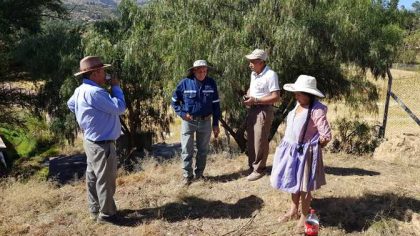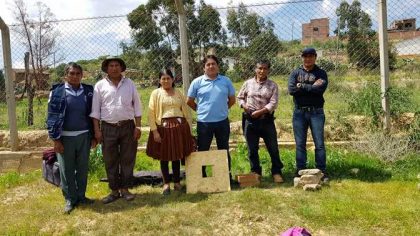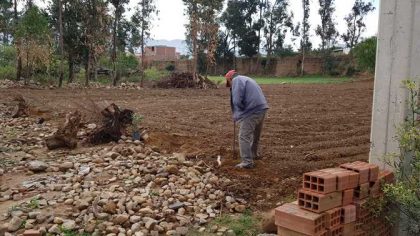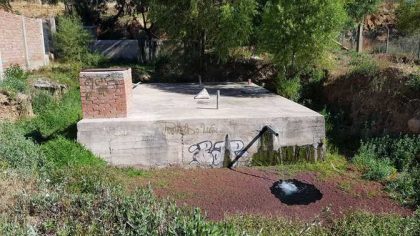This project is made possible through the partnership of WATER CHARITY and the NATIONAL PEACE CORPS ASSOCIATION. ![]()
This project has been completed. To read about the conclusion, CLICK HERE.
 Location
Location
Chinyata, Bolivia
Community Description
Chinyata is a high rural Andean community, located about 20 kilometers from the outskirts of the city of Cochabamba.
Chinyata’s population of 300 families (about 1,800 people) is divided into three geographic clusters whose residents are subsistence farmers with average annual incomes of about $600.
Severe drought has plagued Bolivia’s Andean regions for the past several years.
Problem Addressed
In 2017, the national Bolivian government declared a state of emergency in 172 of the country’s 339 municipalities because of drought-related livestock and crop loss. The drought-affected more than 145,000 farming households with damage to nearly 299,000 hectares of crops and loss of 370,000 cattle.
 Last year Chinyata’s families had no local access to drinking water during the months of August through November. In order to continue living in their community, they had to purchase trucked-in water at an average cost of $170.00 per family for the four-month period. “Water is life”, they said. “We have no choice. Without water, we cannot live”.
Last year Chinyata’s families had no local access to drinking water during the months of August through November. In order to continue living in their community, they had to purchase trucked-in water at an average cost of $170.00 per family for the four-month period. “Water is life”, they said. “We have no choice. Without water, we cannot live”.
The impact of deep rural poverty falls especially hard on women and children. Bolivia’s rural Andean maternal death rate in childbirth of over 500 per 100,000 (compared with 37 in neighboring Chile) is the highest in Latin America. Up to 8% of rural children die at or shortly following birth. Lack of clean drinking water and appropriate nutrition are major contributors to these tragic outcomes.
Project Description
This project is to drill a well in Chinyata.
Given the desperate need to find access to water, Chinyata’s elected community leaders have asked Mano a Mano to drill three deep wells in their community. This specific project involves drilling one of those wells.
Requests from communities to Mano a Mano are followed by extensive discussions that lay the groundwork for developing formal agreements among the elected community leaders, municipal officials and Mano a Mano, and define, prior to initiating the project, the contributions, and responsibilities of each participating partner.
 Community residents will contribute the unskilled labor, locally-available building materials (gravel, and stone), and a portion of the funds for this well. The municipality of Sacaba (local government) will provide the environmental study. Mano a Mano will complete the engineering study, required drilling machinery and partial funding for materials and skilled labor.
Community residents will contribute the unskilled labor, locally-available building materials (gravel, and stone), and a portion of the funds for this well. The municipality of Sacaba (local government) will provide the environmental study. Mano a Mano will complete the engineering study, required drilling machinery and partial funding for materials and skilled labor.
Project goals:
1. Create reliable access to water
2. Reduce the incidence of water-borne diseases
3. Increase the family’s capacity to raise fruits and vegetables that improve the quantity and nutritional quality of its food supply, thus improving daily diet
4. Increase capacity to maintain healthy livestock that can support basic family needs (e.g., milk from cow or goat, eggs from chickens or geese, sheep for wool from which to spin and weave clothing)
5. Make it possible for families to remain in their stable community on land that they own
Recently, Mano a Mano purchased a large truck-based well-drilling rig plus a support truck which makes drilling possible to a depth of 340 meters. To successfully dig a well in these rocky regions, a drill must have the capacity to not only bore to the depth of the water table but also to flush broken rock up to the surface.
 The following steps will be taken to complete the well:
The following steps will be taken to complete the well:
1. Mano a Mano geologist and engineer determine the geological make-up of the site, depth and amount of water available in the area (the point at which they feel confident that sufficient water is available)
2. The municipal engineer will complete an environmental impact study
3. Machine operators drive the drill machine and support truck to the site and set it up. Once positioned and set up, operators will drill a test bore of 3 ½ – 8” in diameter down to the water table (estimated to be about 100 meters) to determine the volume, quality, and flow of the water.
4. Once that determination is made, operators drill a permanent borehole of 8 – 12” in diameter, taking into account the underground storage capacity of the gravel/rock that will surround the casing within the borehole.
5. When the boring is complete, operators, with assistance from community residents, will install the casing, pump, and piping.
6. Together, they will then fill the borehole with gravel and rock, thus protecting the casing and the walls of the borehole and keeping the submersible pump free from working in the dirt. Gradually water will seep into the gravel/rock and serve as additional water storage capacity.
7. Community residents will establish water distribution norms
Project Impact
600 people will benefit from the project.
Project Administration
Joan Velasquez, RPCV Bolivia (’67 – ’69), Co-Founder and Board Member of Mano a Mano.
Monitoring and Maintenance
Mano a Mano, working with local government and community organizations, will monitor the usage and condition of the well. The expected life is 25 years.
The community has an organized water sindicato that is accustomed to taking responsibility for acquiring water, ensuring equitable distribution, protecting and maintaining related infrastructure and resolving issues related to water. The well will be owned communally as represented through the elected leaders of the sindicato.
Mano a Mano’s machine operators will train the sindicato leaders on how the good functions and on proper maintenance. The sindicato has already established its process for collecting funds for the portion that it has agreed to pay for good drilling and for any repairs that may be needed over time. It will select specific individuals to monitor the well to make sure that it is functioning as intended. These individuals will contact them if any problems occur.
Project Funding
This project has been funded by the Paul Bechtner Foundation. Additional donations will be used for other projects in Bolivia.